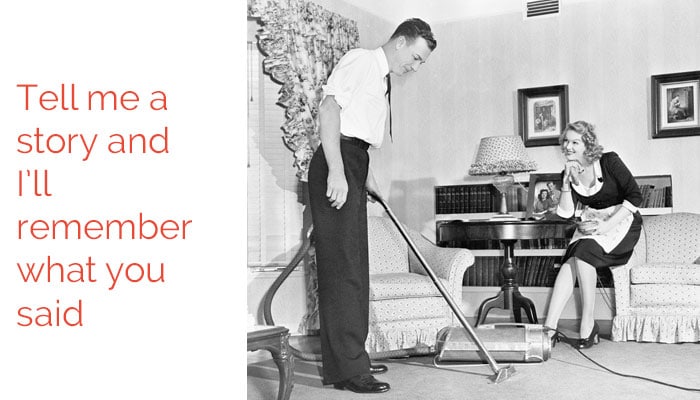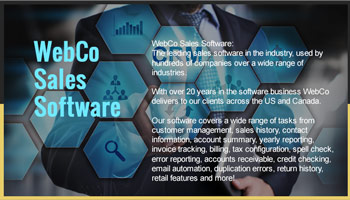
The date is set, the countdown is on – time for gut-churning nerves and crossed fingers. Make no mistake – acing business-winning sales presentations takes more than practice and cue cards.
Here’s a ‘How To’ for wowing your audience and guaranteeing that business-winning handshake comes at the end.
We’ll also cover the design of a presentation, which 90% of presenters get wrong.
BTW, these steps apply to 1-on-1 meetings with prospects or audiences of 100—the techniques are the same. So, let’s get to work…

Audience Member by Audience Member – What Do They Care About?
NOTE: Empathy is required to get this right. Put yourself in your prospect’s shoes and imagine the headaches that make them reach for a Xanax.
Now step into our make-believe conference room for a moment, where Steve is just about to pitch his sales software. Let’s meet the audience…
- First, there’s Calvin – the super smart IT guy. Installing new software programs is one big headache for the IT department. He wants to know it’s proven to work and the level of support he’ll be required to provide to the mere mortals who have no IT background. Most of all, he needs to know you have a team to help him work out the inevitable kinks.
- Then there’s Rochelle – she’s the head sales manager. She cares about one thing and one thing only – conversion. How does Steve’s software improve that?
- Now we come to Fiona – the financial director. She has the final word on all purchases and focuses on the cold hard cash price – rather than ROI. How does the product compare to others and how will it save time and money?
- Finally, there’s Chris – the CEO – his business considerations balance all of the above. How does the product impact the company’s efficiency and bottom line?
People buy something that solves their problem.
Just like Steve, each audience member has different cares, concerns and pain points that keep them up at night. Include content that makes your presentations persuasive for all of them.
Many notable presenters arrive early, talk to people, take the pulse of the audience, then tweak their presentation just for them.
Read what master presenter, Brian Carter does to set the stage

It’s storytime…
Humanizing your story creates a firm foundation for forging a genuine connection with your audience. After all, people don’t buy from companies – they buy from people they know, like and trust.
Steve should start with a story about himself.
No, this is not counter-intuitive to being customer-focused.
When he tells a story about why he got into the sales software business, it shows his enthusiasm for solving problems and he creates a positive emotion. If he makes people laugh, home run. They will remember what he said!
For instance, he might talk about his grandfather who was a door-to-door vacuum cleaner salesman and how he kept a detailed notebook of all his customers, an obviously tedious task. Now Steve wants to make that process easier for other salespeople with his software. See? This makes Steve knowable and likable.
Now on to trust.
Offer instant pain relief
Here’s the thing – at this stage, your audience doesn’t care about detailed product specs, a long list of service features or upgrade options. It’s too early. Right now, they care only about their problem. Deliver value here.
So the next thing you need to do is to show them you get it, you understand their challenges and swiftly prove that you can resolve them. No need to talk about specs!
Talk about how your product:
- Easily integrates with current programs and how your support team sits right next to you during the transition, so Calvin can relax.
- Show how your software send automatic emails so Rochelle doesn’t have to.
- Talk about how it tracks customer history at a glance from her phone, so when she’s running to a meeting she can catch up on the customer
- Compare price/features with another product to show Fiona it’s better, cheaper or different.
- Mention the increased efficiency will improve the company’s bottom line. The CEO will notice.
This shows value, which creates trust.
Demonstrate Concrete Proof That Your Product or Service Solves Their Problem
How? Through stories! Another big trust-builder.
Use case studies from similar clients – those who are over-the-moon to have chosen you.
Build a little suspense here:
- Describe the migraine a problem gave a customer
- How you pulled a rabbit out of the hat to solve it
- The amazing result!
- Collect cast-iron statistics that demonstrate results with numbers
- Finish with a glowing video testimonial from another client
Give a gift:
Freebies – everybody loves them. Allow your audience to walk away with something they can use or advice they can action today – something that will prove to be an irresistible taste of what’s to come if they commission your services or purchase your products.
This could come in the form of a product sample, white paper, infographic or free trial run with your service. Whatever form it takes, it should prove your worth.
Remember Your Call to Action
Many presenters forget to ask for something at the end. What do you want people to do?
A few ideas:
- Give a handout with your contact info with a summary of your main points and a tear-off panel they can fill in their contact info and leave with you
- Offer a demonstration at their office
- Collect biz cards and give away a prize
Follow up after your presentation with an email or gift to attendees. You could include:
- an article of interest to them
- an invite to another event
- introduction to someone they would benefit knowing
- Send a funny or informative book through the mail. Yes, the mail.
Designing Business-Winning Sales Presentations
Your slides – Make them mercifully brief
Death by PowerPoint – it’s an all too common and fatal condition when it comes to killing off your shot at a contract. So make your slides short and succinct. If you have more than 3 bullet points on one slide, shoot it down. (See actual example below) No one beyond the first row could read this.
Choose images that make people feel something
A slide with a seemingly random image can pique your audience’s interest effectively if it has some emotion! Use a photo unrelated to your product directly, like a funny dog using a laptop for Steve’s software. (just take a look through a few TED presentations and you’ll quickly notice a pattern emerging). Interrupt the viewer’s thought process with the unexpected.

What not to do: Boring headline, generic image, information dump.

A simple, attention-getting slide. Engaging headline, immediate benefit.
Information Dumping: Just Don’t Do It!
Blahhhhhh. That’s all your audience hears when you ‘brain dump’ onto your slides (we’ve all seen them, like the one above – slides with way too many words, covering way too many different points). To top it off, The text is over an image, making it nearly impossible to read anyway.
Keep it clear and focused or people will just tune out. This is not the place for excruciating detail or laundry lists of services. Prepare a handout for that.
Do Away with Jargon and Technical Talk
Urgh, corporate jargon – it’s the last thing you need when trying to energize and inspire (rather than bore and frustrate). Dump the technical specs and liven up your language to keep your audience connected. Stick to showing value.
- It’s not “exceeding expectations”, it’s “knocking their socks off”
- You don’t “meet targets” you “crush goals”
- They’re not about to make a good decision by choosing you, they’re “whip-smart for choosing a savvy solution built for their business”.
Using uncommon language grabs attention, creates energy and creates business-winning sales presentations.
Learn more about our Presentation Design work here
Zzzzzz’s: How to Avoid Them
You know how it is – it’s Monday, the heat is turned up, your audience is clock-watching. You need to wake them up, grab their attention and hold their focus. For this challenge, you must:
- Make eye contact with people
- Move around the room
- Be animated with your body language
- Vary your tone of voice
Practice and more practice!
This is not the time to wing it!
If you heard point 1 about keeping slide content to a minimum, that means you must fill out your presentation verbally. To do this, practice often!
Comedians practice their routines a million times before they go on stage. It looks spontaneous, but it is well-practiced.
Use slides as a background to your dialog, not to convey every single detail of your product. It’s not a catalog!
- Have one catchy headline or a picture on a slide then fill in the rest verbally. To do this, you must practice talking into it.
- Make notes on the side and go over it many times in front of your family, a professional coach or walking the dog.
- Vary your tone of voice, allow pauses and emphasize important words. Just watch anything Alan Rickman has done and you’ll get the idea. He makes every word juicy!
- Did we say practice?
Mastering business-winning sales presentations is far from a straightforward task – it takes diligent preparation, plenty of creativity and painstaking research.
You must know who your audience is and what they truly care about and need. All of which demands the skills of a specialist company.
Sales presentations are different from Pitch Deck Presentations, which are formatted specifically for Investors. Read more about creating a winning Pitch deck
Need presentation training?
When you need training for live appearances and networking events, give us a call. Our training specialist will prepare you so you speak with confidence and wow your audience.
Which is handy, as we know all about killer sales presentations that win business. Sound interesting? We’re ready to open more wallets for you – send us a message and let’s have a conversation.






